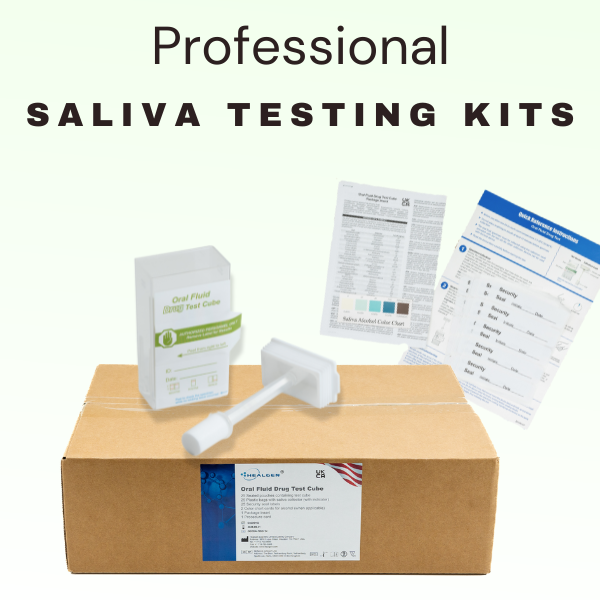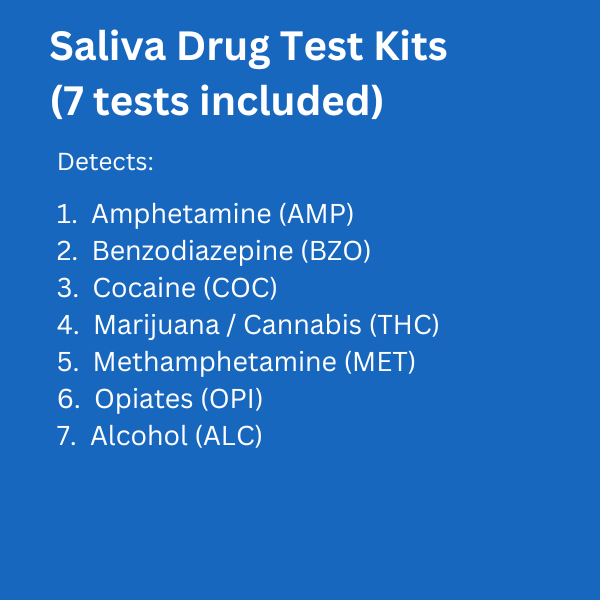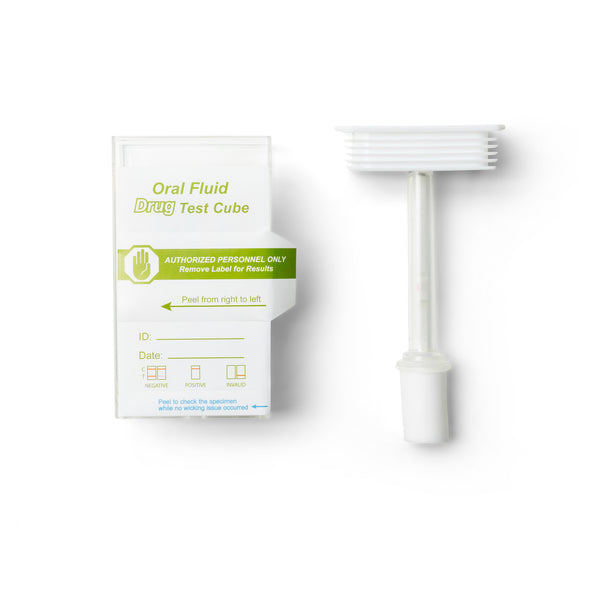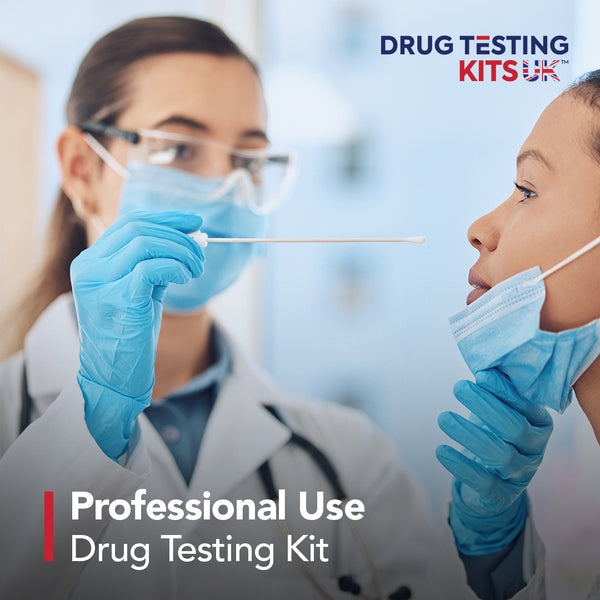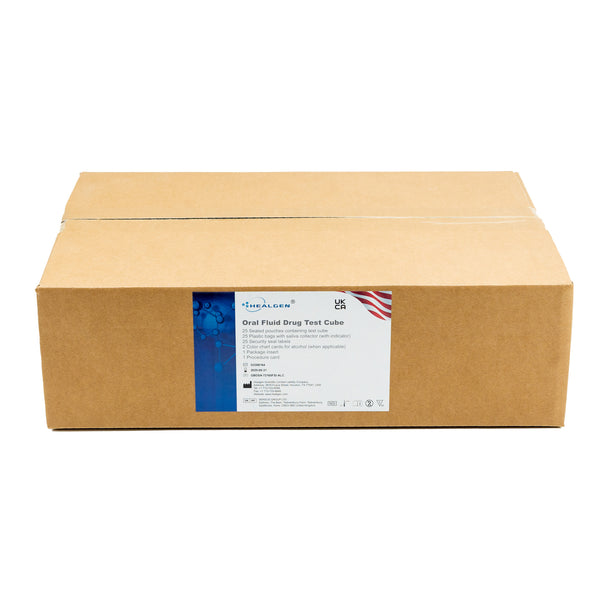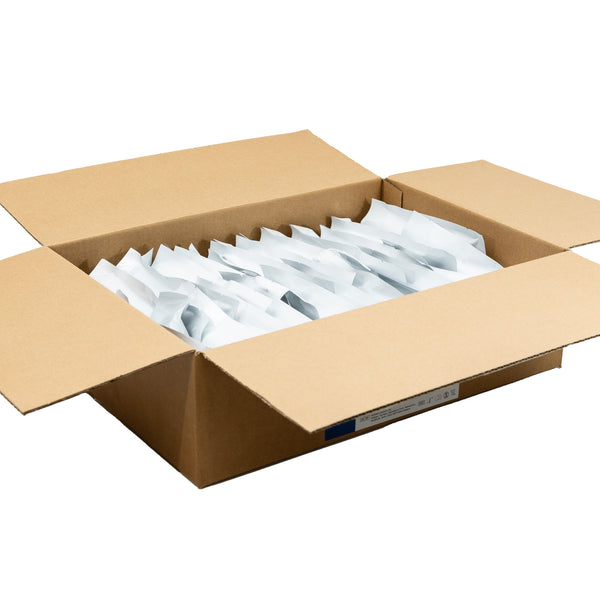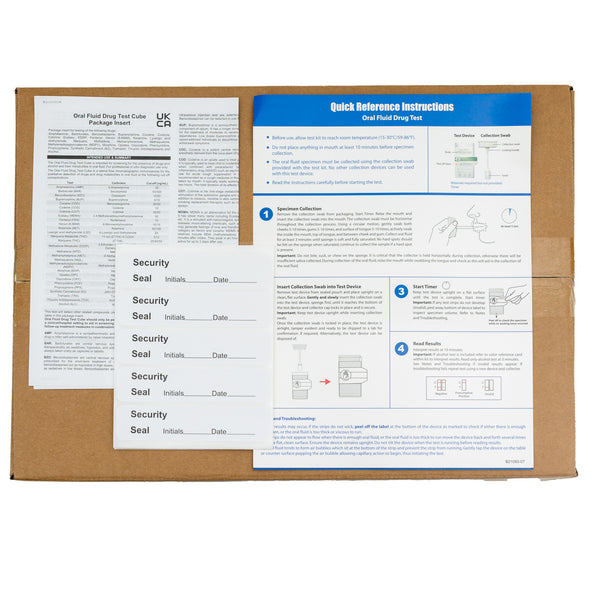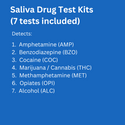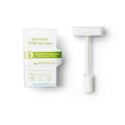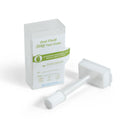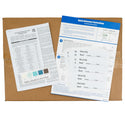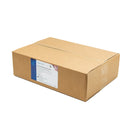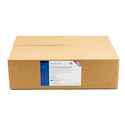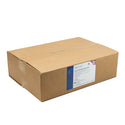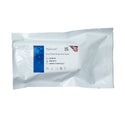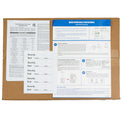This information is provided for general informational purposes and does not constitute legal advice. It's important to consult with legal counsel or relevant professional resources to ensure compliance with UK regulations regarding pre-employment drug testing and employer policies.
When you see those flashing blue lights in your rearview mirror or consider using a personal alcohol tester before driving home, have you ever wondered exactly how these devices determine your sobriety level? Breathalyzers have become commonplace tools used by both police officers and everyday people, yet many of us don't fully understand the science behind how they actually work.
Whether you're curious about the technology, considering purchasing a personal breathalyzer, or simply want to understand what those numbers mean, this guide will walk you through the inner workings of breathalyzers. We'll explore what they actually measure, how they calculate your results, and why accuracy matters when it comes to making responsible decisions.
What Is a Breathalyzer?

A breathalyser is a portable electronic device designed to estimate blood alcohol concentration (BAC) by analyzing a sample of your breath. The name "breathalyzer" was originally a brand name that has since become a generic term for any device that measures alcohol in breath—similar to how "Hoover" became synonymous with vacuum cleaners.
These devices come in various forms:
-
Law enforcement models: Highly calibrated devices used by police for roadside testing and evidential purposes
-
Personal breathalyzers: Ranging from keychain-sized units to smartphone attachments
-
Workplace testing devices: Used in safety-critical industries like transportation and construction
-
Home monitoring systems: Sometimes court-ordered for drink driving offenders
What many people don't realize is that not all breathalyzers are created equal. They utilize different sensor technologies, which significantly impacts their accuracy and reliability—something we'll explore in detail later.
What Does a Breathalyzer Measure?

Contrary to what many believe, breathalyzers don't directly measure how drunk you are. Instead, they detect ethanol vapor (alcohol) in your exhaled breath. This measurement is then converted into an estimated blood alcohol concentration.
In the UK, police breathalyzers measure alcohol in micrograms (μg) per 100 milliliters of breath. The legal limit in England, Wales, and Northern Ireland is 35 micrograms of alcohol per 100 milliliters of breath. Scotland has a stricter limit of 22 micrograms.
For context, these breath measurements correspond to approximately:
-
England, Wales, NI: 80mg of alcohol per 100ml of blood
-
Scotland: 50mg of alcohol per 100ml of blood
This conversion uses what's known as a "partition ratio" of roughly 2,100:1, meaning the amount of alcohol in 2,100ml of breath equals the amount in 1ml of blood. This standardized ratio is built into breathalyzer calculations, though it can vary slightly between individuals.
How Alcohol Gets From Your Drink to Your Breath
To understand how breathalyzers work, it helps to follow alcohol's journey through your body:
-
Consumption: You drink alcohol
-
Absorption: Your stomach and small intestine absorb the alcohol into your bloodstream
-
Circulation: Your heart pumps this alcohol-containing blood throughout your body
-
Lungs: Blood vessels in your lungs allow alcohol to evaporate into the air sacs (alveoli)
-
Exhalation: When you exhale, you breathe out air containing alcohol vapor
This process explains why breathalyzers require a deep breath from your lungs rather than just a puff from your mouth. The deepest part of your exhaled breath—called "alveolar air"—contains the most accurate concentration of alcohol that correlates with your blood levels.
It's also why waiting 15-20 minutes after your last drink before testing is crucial. This allows any residual mouth alcohol (which would give falsely high readings) to dissipate, ensuring the device measures only the alcohol that has actually entered your bloodstream.
How Does a Breathalyzer Convert Breath to BAC?
When you blow into a breathalyzer, it doesn't directly measure your blood alcohol level—it measures the alcohol in your breath and then calculates what your blood alcohol concentration likely is.
This calculation relies on Henry's Law, a scientific principle stating that when a liquid containing a volatile compound (like alcohol) comes into contact with air in a closed container at a constant temperature, the compound will distribute itself between the air and liquid in a predictable ratio.
In practical terms:
-
The breathalyzer detects alcohol molecules in your breath
-
It applies the standard partition ratio (2,100:1)
-
It calculates and displays your estimated BAC
While this ratio is fairly consistent, it can vary based on factors like body temperature, red blood cell concentration, and even the ratio of exhaled air to alveolar air in your breath sample. This is why breathalyzer results are considered estimates, albeit scientifically sound ones that courts accept as evidence.
Types of Breathalyzer Sensors
Not all breathalyzers use the same technology to detect alcohol. The sensor type significantly impacts accuracy, reliability, and price—making it one of the most important factors to consider when choosing a personal device.
Semiconductor Sensors

Most budget-friendly personal breathalyzers use semiconductor oxide sensors.
How they work:
-
Alcohol molecules in your breath come into contact with a metal oxide semiconductor
-
The alcohol oxidizes on the sensor's surface
-
This changes the electrical resistance of the semiconductor
-
The device measures this change and converts it to a BAC reading
Pros:
-
Affordable (typically £20-£60)
-
Compact and portable
-
Require less power to operate
Cons:
-
Less accurate than professional-grade sensors
-
Can be affected by temperature, humidity, and cigarette smoke
-
May detect other compounds similar to alcohol (false positives)
-
Require more frequent recalibration
-
Accuracy degrades over time
Semiconductor breathalyzers are suitable for personal guidance but may not provide the precision needed for critical decisions.
Fuel Cell Sensors

Professional and police-grade breathalyzers typically use fuel cell technology, which offers superior accuracy and reliability.
How they work:
-
Your breath passes over a fuel cell containing two platinum electrodes
-
Alcohol oxidizes at one electrode, producing acetic acid, protons, and electrons
-
The electrons flow through a wire connecting the electrodes, creating an electrical current
-
The strength of this current is directly proportional to the amount of alcohol present
-
The device measures this current and calculates your BAC
Pros:
-
High precision (typically ±0.01% BAC)
-
Specific to ethanol (fewer false positives)
-
More stable in varying environmental conditions
-
Longer-lasting accuracy
-
Less frequent calibration needed
-
Used by law enforcement worldwide
Cons:
-
More expensive (typically £80-£300)
-
Slightly larger than semiconductor models
-
Higher power requirements
For those serious about accurate readings, fuel cell breathalyzers are worth the investment. Drug Testing Kits UK recommends fuel cell models for their reliability and longevity, especially for regular users or those who need dependable results.
How Do Police Breathalyzers Work?
Police in the UK use a two-stage breath testing process:
Stage 1: Roadside Screening
-
Officers use portable breathalyzers (typically fuel cell models)
-
These provide a quick indication of whether you're likely over the limit
-
A positive roadside test is not evidential but gives officers grounds to arrest you
Stage 2: Evidential Testing
-
At the police station, you'll be tested on an approved evidential device
-
These are typically larger, more sophisticated machines using fuel cell or infrared technology
-
They require two separate breath samples taken a few minutes apart
-
The lower of the two readings is used as evidence
-
These devices are regularly calibrated and maintained to ensure accuracy
The legal limits in the UK are:
-
England, Wales, Northern Ireland: 35 micrograms per 100ml of breath
-
Scotland: 22 micrograms per 100ml of breath
If the evidential test shows you're over the limit, you may be charged with drink driving. In some cases, you can request a blood or urine test instead, particularly if the breath reading is borderline or if you have a medical condition affecting your breathing.
How Accurate Are Breathalyzers?
The accuracy of breathalyzers varies significantly based on several factors:
Sensor Technology
-
Fuel cell sensors: Typically accurate to within ±0.01% BAC
-
Semiconductor sensors: Generally accurate to within ±0.02-0.03% BAC
-
Infrared spectroscopy: Can be accurate to within ±0.005% BAC
Calibration Status
All breathalyzers require periodic calibration to maintain accuracy. This involves testing the device against a known alcohol standard and adjusting it if necessary. Police units are calibrated regularly, while personal devices may need professional calibration every 6-12 months (or as specified by the manufacturer).
User Technique
Proper usage significantly impacts accuracy:
-
Waiting at least 15-20 minutes after your last drink
-
Taking a deep breath and blowing steadily
-
Avoiding contamination from food, mouthwash, or cigarettes
-
Following the specific instructions for your device
Environmental Factors
-
Temperature extremes can affect readings
-
High altitude may impact some devices
-
Electromagnetic interference can disrupt electronic components
For legal purposes, police breathalyzers in the UK must meet strict accuracy standards set by the Home Office. Personal breathalyzers, while useful, don't have the same regulatory requirements—which is why investing in a quality fuel cell model is advisable if accuracy is important to you.
Blood Alcohol Concentration (BAC) and Its Effects
Understanding what BAC numbers actually mean in terms of impairment helps put breathalyzer readings into context:
|
BAC (%) |
Effects on the Body |
Likely Outcome |
|
0.01-0.03 |
Slight mood changes, mild relaxation |
Legally sober in UK |
|
0.04-0.06 |
Feeling of warmth, minor judgment impairment, relaxation |
Below UK limit but driving skills affected |
|
0.07-0.09 |
Reduced coordination, difficulty tracking objects, impaired judgment |
Near or over UK limit (0.08% in England) |
|
0.10-0.12 |
Slurred speech, poor coordination, slowed thinking |
Significantly impaired, well over legal limit |
|
0.13-0.15 |
Major motor impairment, blurred vision, significant loss of judgment |
Dangerously impaired |
|
0.16-0.20 |
Nausea, dysphoria, disorientation |
Severe impairment, possible blackout |
|
0.25+ |
Alcohol poisoning, unconsciousness, risk of death |
Medical emergency |
It's important to note that impairment begins well before you reach the legal limit. Even at BAC levels of 0.02-0.04%, reaction time and coordination are already affected. The legal limit isn't a "safe to drive" threshold—it's the point at which driving becomes a criminal offense.
Individual factors also significantly impact how alcohol affects you:
-
Body weight and composition
-
Gender (women typically process alcohol more slowly)
-
Food consumption
-
Hydration levels
-
Medications
-
Tolerance
-
Fatigue
This is why responsible drinkers often set their personal limit well below the legal threshold.
How to Use a Breathalyzer Correctly

To get the most accurate results from a personal breathalyzer:
-
Wait after drinking: Allow at least 15-20 minutes after your last sip of alcohol before testing. This ensures mouth alcohol doesn't skew your results.
-
Avoid contamination: Don't eat, drink, smoke, or use mouthwash right before testing. These can contain substances that affect readings.
-
Take a deep breath: Breathe normally, then take a deep breath and exhale steadily into the device. The alcohol-rich air from deep in your lungs provides the most accurate sample.
-
Follow timing instructions: Blow for the full duration recommended by your device (typically 5-6 seconds).
-
Wait between tests: If taking multiple readings, wait 1-2 minutes between tests to allow the sensor to reset.
-
Maintain your device: Clean the mouthpiece regularly with alcohol-free wipes. Store in a dry place at room temperature.
-
Calibrate as needed: Follow the manufacturer's recommendations for calibration frequency (typically every 6-12 months for fuel cell models).
-
Replace batteries promptly: Low battery power can affect sensor performance.
Remember that even the best personal breathalyzers have limitations. If you're close to the legal limit or feel impaired regardless of your reading, the safest choice is always to avoid driving.
Why Use a Personal Breathalyzer?
Personal breathalyzers serve several important purposes beyond just checking if you're legally able to drive:
Morning-After Testing
Many drink driving arrests occur the morning after drinking when people still have significant alcohol in their system. A personal breathalyzer can help you determine if you're safe to drive after a night out.
Self-Monitoring
For those who enjoy social drinking, a breathalyzer provides objective feedback about your intoxication level, helping you learn how different drinks affect your BAC.
Parental Monitoring
Parents may use breathalyzers to check if teenagers have been drinking, creating accountability and opening conversations about alcohol safety.
Workplace Safety
In safety-critical jobs, employees might use personal devices to ensure they're compliant with workplace alcohol policies.
Peace of Mind
Simply knowing your BAC can reduce anxiety about whether you're making a responsible decision.
Drug Testing Kits UK offers a range of fuel cell breathalyzers that provide reliable, accurate readings comparable to those used by law enforcement. All products ship in discreet packaging with fast delivery throughout the UK, and our team is available to help you choose the right device for your needs.
Frequently Asked Questions
How does a breathalyzer detect alcohol?
A breathalyzer detects ethanol molecules in your exhaled breath using either semiconductor, fuel cell, or infrared technology. When alcohol in your breath contacts the sensor, it triggers a chemical reaction that produces an electrical signal. The device measures this signal and converts it to a BAC reading using a programmed algorithm based on the 2,100:1 breath-to-blood ratio.
Are breathalyzers accurate for home use?
Home breathalyzers vary in accuracy depending on the sensor technology and quality. Fuel cell breathalyzers offer professional-grade accuracy (within ±0.01% BAC) and are suitable for serious home use. Budget semiconductor models are less precise but can still provide useful guidance if you understand their limitations. For maximum accuracy, choose a fuel cell device and follow proper testing procedures.
How long after drinking will I pass a breathalyzer test?
The average person metabolizes alcohol at approximately 0.015% BAC per hour, though this varies by individual. For example, if your BAC reaches 0.08%, it would typically take about 5-6 hours to return to zero. Factors like body weight, gender, liver function, and food consumption affect this timeline. There's no reliable way to speed up alcohol metabolism—coffee, cold showers, and exercise don't significantly impact your BAC.
Why does my reading change between tests?
Variations between consecutive breathalyzer readings can occur due to several factors: inconsistent breathing technique, residual mouth alcohol dissipating, the device warming up, or sensor stabilization. For most accurate results, wait 1-2 minutes between tests and use the average of multiple readings. If readings vary significantly (more than 0.02% difference), wait longer before retesting or check your device's calibration.
Do home breathalyzers work like police ones?
High-quality personal fuel cell breathalyzers use the same core technology as police units but may differ in precision, calibration standards, and additional safeguards. Police devices undergo more rigorous testing, maintenance, and certification. While a good personal breathalyzer can provide readings comparable to police screening devices, only officially approved evidential breathalyzers at police stations are admissible as court evidence in the UK.
Can breathalyzers detect drugs?
Standard breathalyzers only detect alcohol, not drugs. They're specifically designed to react with ethanol molecules. For drug detection, specialized devices called "drug testing breathalyzers" or oral fluid drug tests are required. These work differently from alcohol breathalyzers and test for specific drug compounds rather than alcohol. If you need to test for both substances, separate testing devices are necessary.
Making Informed Decisions with Breathalyzer Technology
Breathalyzers have transformed from purely law enforcement tools to personal safety devices that empower individuals to make more informed decisions. By measuring alcohol molecules in your breath and applying scientific principles, these devices provide valuable insight into your level of impairment.
Understanding how breathalyzers work—from the science behind alcohol absorption to the different sensor technologies—helps you choose the right device and interpret results correctly. Remember that the most accurate readings come from quality fuel cell devices used properly, with an understanding that individual factors always play a role in how alcohol affects you.
Whether you're concerned about morning-after driving, monitoring your own consumption, or creating a safer environment
Not selected
Whether you're concerned about morning-after driving, monitoring your own consumption, or creating a safer environment for others, a reliable breathalyzer can be an invaluable tool for responsible decision-making.
Want to check your alcohol level safely and accurately? Browse our range of personal breathalyzers trusted across the UK. Our fuel cell models offer police-grade accuracy with discreet delivery and expert support to help you make informed choices about alcohol consumption and safety.
The Future of Breathalyzer Technology
As technology advances, breathalyzers continue to evolve with new features and capabilities:
Smartphone Integration
Modern breathalyzers increasingly connect to smartphones via Bluetooth, offering advantages like:
-
Detailed tracking of BAC levels over time
-
Personalized feedback based on your drinking patterns
-
Estimated time until you're sober
-
GPS integration to help find safe transportation
These smart breathalyzers make the technology more accessible and user-friendly, encouraging responsible habits through data visualization and timely reminders.
Miniaturization
The trend toward smaller, more discreet devices continues, with some modern breathalyzers now small enough to fit on a keychain while maintaining reasonable accuracy. This portability makes it more likely that people will have a breathalyzer available when needed.
Improved Accuracy
Advances in sensor technology are gradually reducing the price gap between semiconductor and fuel cell devices, making professional-grade accuracy more affordable for personal use. Some newer models also incorporate temperature compensation and pressure sensors to adjust for environmental variables.
Biometric Authentication
To prevent tampering or misuse (particularly in monitoring programs), some advanced breathalyzers now include facial recognition or fingerprint verification to ensure the intended person is taking the test.
Legal Considerations in the UK
Understanding the legal framework around breathalyzers in the UK helps put their use in context:
Drink Driving Limits
The legal limits for driving in the UK are:
-
England, Wales, and Northern Ireland: 80mg of alcohol per 100ml of blood (0.08% BAC), 35μg per 100ml of breath, or 107mg per 100ml of urine
-
Scotland: 50mg of alcohol per 100ml of blood (0.05% BAC), 22μg per 100ml of breath, or 67mg per 100ml of urine
These limits are higher than many European countries, where 0.05% or even 0.02% BAC limits are common.
Refusing a Breath Test
In the UK, refusing to provide a breath sample without reasonable excuse is an offense that carries penalties similar to failing the test itself—including driving bans, fines, and possible imprisonment.
Personal Breathalyzer Results
It's important to note that results from a personal breathalyzer cannot be used as a defense in court if you're charged with drink driving. Police will always use their own calibrated devices for official testing.
Making the Most of Your Breathalyzer
To ensure your personal breathalyzer remains a reliable tool:
Regular Maintenance
-
Check the manufacturer's guidelines for calibration frequency
-
Keep the device clean and store it properly
-
Replace batteries before they're completely depleted
-
Consider professional recalibration services for long-term accuracy
Responsible Interpretation
-
Remember that impairment begins before you reach the legal limit
-
Set personal limits below the legal threshold
-
Consider individual factors that might make you more sensitive to alcohol
-
Never use a breathalyzer as justification to drive when you feel impaired
Complementary Safety Measures
A breathalyzer works best as part of a comprehensive approach to alcohol safety:
-
Plan transportation before you start drinking
-
Use designated drivers or public transport
-
Consider alcohol-free alternatives when driving
-
Allow ample time between your last drink and driving
Conclusion
Breathalyzers work through a fascinating combination of chemistry, electronics, and physiology to provide a window into how alcohol is affecting your body. By detecting ethanol molecules in your breath and applying scientific principles, these devices translate invisible biological processes into actionable information.
Whether you choose a basic semiconductor model for occasional use or invest in a police-grade fuel cell device for maximum accuracy, understanding how your breathalyzer works helps you use it effectively and interpret results appropriately.
The most important thing to remember is that any breathalyzer is a tool to support—not replace—good judgment. If you feel impaired, you probably are, regardless of what a device says. The safest approach is always to separate drinking from driving entirely.
Want to check your alcohol level safely and accurately? Browse our range of breathalyzers trusted across the UK. Our fuel cell models offer police-grade accuracy with discreet delivery and expert support to help you make informed choices about alcohol consumption and safety.



 03333 704 704
03333 704 704


